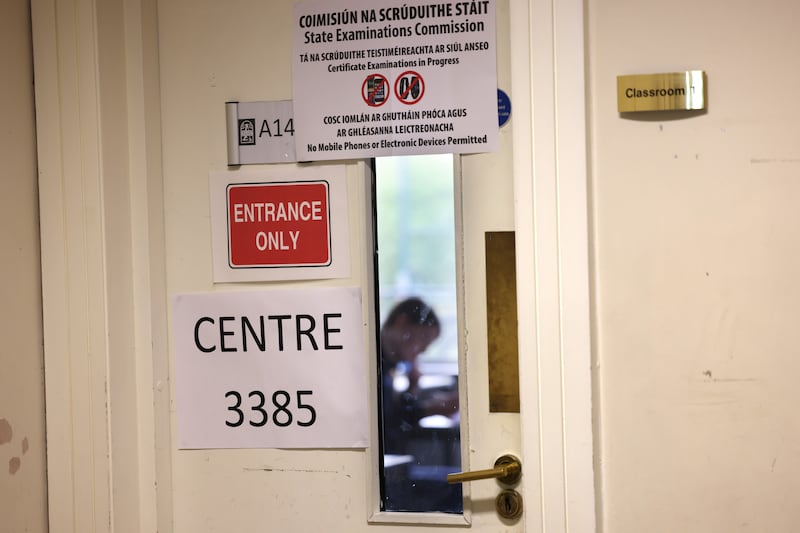* Leaving Cert students had geography (9.30am) and maths paper one (2pm)
* Junior Cycle students had history (9.30am) and maths (1.30pm) this afternoon.
* ‘It was always bound to be the most stressful of all... the questions were quite odd’: Our student diarist Daksh Wadhwa is glad to see the back of yesterday’s exam
* ‘Help them focus on the next challenge’: Exam survival guide for students parents by Brian Mooney
That’s a wrap...
So, the exam halls are empty once again.
We hope you were among the happy and relieved students leaving them earlier today.
Be sure to take some time for a well-deserved breather over the weekend.
You deserve it.
We’re finishing up our live blog now, but we have some last-minute tips for maths paper two, Irish, French and biology over the coming days.
We’ve also have some tips for balancing your health, mind and body.
We’ll leave you with these wise words from Anne Conway, a guidance counsellor at Clogher Road Community College in Dublin:
“Get away from the desk, go to the gym, play sport or get exercise. Have a positive mindset, and keep talking...
“We know the course is massive. We also know how much content your brain has to take in – but it can’t do this if you haven’t eaten properly and taken breaks. Remember that 20 minutes of good study is better than an hour of broken, distracted study.”
Junior Cycle maths: A mostly fair paper with a sting in the tail
There was a mostly positive response to today’s Junior Cycle (higher level) maths paper.
We’ve a detailed reaction piece here, with links to the higher level and ordinary level papers.
Niall Duddy, a teacher at Presentation College Athenry and ASTI subject representative, said that the paper was largely accessible, but there was a sting in the tail with some of the later questions.
Stephen Begley, Studyclix.ie subject expert and head of maths at Dundalk Grammar School, said that the higher level paper was dynamic in ways, although overall a candid, fair and balanced exam.
“The usual suspects of statistics, coordinate geometry, trigonometry and area & volume came out in force throughout the paper, which are emerging as trendy each year,” he said.
Leaving Cert maths paper one: ‘It was nice... paper two may be a bruiser’
My colleague Peter McGuire has filed a separate reaction piece to maths paper two.
The consensus among maths teachers is that this was a fair and accessible paper, in contrast to controversy last year when many students left exam halls in teams.
In fact, as teacher Niall Duddy says, it may have been too nice.
“There is, however, some concern among students that, because paper one was nice, paper two may be a bruiser,” he says. “It remains to be seen.”
You can read Peter’s reaction piece here.
Leaving Cert maths (higher level): Relief over ‘fair’ exam with ‘clear’ questions
There was relief among many Leaving Cert maths students after the higher level exam provided a clear presentation of questions and an emphasis on core skills.
Brian Scully, maths teacher at the Institute of Educatio said many students entered the exam hall anxious given the controversy over last year’s highly challenging paper which left many students in tears.
However, he said everyone should have been reassured with opening questions which were clear and familiar.
“They were accessible tests of mathematical skill unobscured by reading comprehensions,” he said.
“Questions followed trends from previous papers: graphs, areas and volumes, and the mingling of algebra and calculus will all have been welcomed by those who had been studious in their practice. Towards the latter parts of Question 3, which examined students’ understanding of a derivative, we started to see the material get more complex, prompting an agile approach to the concepts, but this was part of an extraordinarily fair exam that sought to represent a wide range of abilities.”
He said there were challenges on the paper that allowed those striving for the very top grades to distinguish themselves.
“Students who were mindful to cover all elements of the course will find that paying dividends as every question combined units,” he said.
“There was nothing too stark and every question offered manageable introductions but someone taking an overly segmented approach to the material will find the later steps challenging. There were places where a student could trip up, but these were the exception rather than the rule.”
Some of the upper end questions would have caused students to pause momentarily, he said.
For example the graph in question 8 (D) and the cap of a sphere in 9 (A) would look unfamiliar at first glance, the latter being rather niche.
“Yet the mathematical principles at play just beyond that first impression were manageable to those well attuned to the underlying principles,” he said. “While these moments may have daunted some, they were outliers to be capitalized on by top students.”
He added: “Ultimately, students will find more than enough opportunities to apply their practice. With more than 50% of the paper emphasizing core skills, students should leave the exam hall feeling they had a fair chance to reflect their work to date.”
Stephen Begley, a maths teacher at Dundalk Grammar School and subject expert for Studyclix, also described the exam as “a very welcome, generous doable paper one”.
“Students were content leaving the exam hall this afternoon remarking on a fair and doable paper,” he said. “While it wasn’t without challenge, at higher level standard that is expected.”
He said section A questions were accessible and students would have built up a rolling confidence working through them.
“The usual suspects of algebra, complex numbers, calculus, sequences and series and functions spanned the short questions. Smiles would have been on many faces working through the simultaneous equations, first principles and De Moivre’s questions,” Begley said.
“Section questions were easily read, concise and directly guided students to what was being asked, with no vagueness to the approaches needing to be applied. As far as Section A’s go, this was rather lovely, fair and well rounded.”
Having to complete only three of the four long questions was an immediate advantage to students, he said, a legacy of the accommodations made since the pandemic.
“Notorious for being lengthy, this year made for a generous set of long questions,” he said., “Question 7 covered financial maths and some standard differentiation and integration.”
He said the questions were clear and direct in what they were looking for, and stated the methods that students should use, such as integration or differentiation.
“Question eight was a lovely functions question that opened with a very easy table and graph. This was followed by trigonometric functions with some parts that needed a little thinking time, though were very workable,” he said.
“Looking at question nine, students may have been shocked initially by the formula and diagram provided. However, once they read the question, they could see it was just some straight forward functions and algebra hidden within these alongside a touch of rates of change,” he said.
Finally, question 10 - which covered functions, differentiation and integration, was “direct, well prompted, though students may have found the closing parts a little tenacious”.
“Overall, the paper was rather functions and calculus heavy, though students appeared content with the start of this two course race. Students will enter their weekend of study ahead of paper two quite content with what was a generous, accessible and balanced exam,” Begley said.
Ordinary level
The Leaving Cert maths ordinary level paper, meanwhile, was an “accessible paper” and “rich in opportunities for marks”.
Jean Kelly, maths teacher with the Institute of Education, said the paper will have pleased many students.
“The usual suspects appeared in the usual ways, so there were no big shocks in a subject that often makes students worried. The paper was heavy on algebra and arithmetic (ratios, percentages, cross method etc.) and very light on calculus: a combination that many will be very pleased with,” she said.
Kelly said one of the best things about the paper was how the exam setter made it absolutely clear what the student was expected to do by offering useful clarifications or, in some cases, overt hints.
“This meant that nothing was hidden behind awkward phrasing, so students could just get stuck into the maths straight away. This was particularly good for students who know how to work through the problem but are anxious about where to start to get it rolling. This paper really helped those students find their footing and display their ability,” she said.
Naturally, there were challenges in the mix as well.
Kelly noted that Q5 (C) asked about the “rate of change” on a graph, and while the task wasn’t too tricky students did need to grasp the underlying concept.
Additionally, the Trapezoidal Rule which is often thought of as paper two material appeared in what might be a surprise to some.
“It did appear on last year’s paper one and so this might be the first sign of a new pattern appearing. These tougher moments were the minority on the paper and only would impact on who get the very top marks,” she said.
“Previous years’ papers often some trickier moments that would have caused students to get stuck and worry, sending them into Paper 2 desperate for every mark. This year, students of all abilities should go into the weekend relieved that their practice and study will have paid off.”
Stephen Begley, head of maths at Dundalk Grammar School and Studyclix subject expert, also said most ordinary level students were “happy out” leaving the exam.
“With many remarking on a fair and doable paper, they were delighted with the questions asked,” he said. “Algebra and functions dominated the paper alongside financial maths. The short questions in Section A provided a gentle ease into the exam covering the usual suspects of arithmetic, complex numbers, algebra, differentiation and functions. These questions were direct and clearly asked what was required of students,” he said.
In section B, which is worth 50 per cent of the grade, he saud students would have been happy to see a “decent” question seven covering functions and calculus to pick off some “easy marks”.
Begley said question eight - which merged distance, speed and time with sequences and series - gave students a chance to gather accessible marks around the graph, alongside using some common formulae for Sequences & Series in their log tables.
“For those nifty with arithmetic and functions, question 9 would have been a delight and threw in a lovely quadratic equation. Question 10 was all financial maths, so for those savvy with their money this was right up their street, though it required quite a lot of reading and a little algebra towards the end,” he said.
“Overall, ordinary level maths paper one was a great start to the maths exams. While paper two looms on Monday, students are hopefully entering the weekend of study with a confidence built from a good, approachable and very doable paper one.”
The times truly are a-changin’
You know you’re getting older when your record collection appears in the Junior Cycle history paper.
Bob Dylan’s The Times They Are A-Changin’ popped up in today’s paper, where candidates were asked whether “songs/album covers are useful sources of evidence about the past”.
Students were also asked what age Dylan (”born in 1941″) was when the album was released (”January 13, 1964″).
As one reader pointed out, there are two possible answers depending on when he was born (22 or 23 years).
We presume candidates will get top marks for either answer.
(Since you didn’t ask, he was 22 years and seven months when the album was released).
In another interesting question, Junior Cycle history candidates were shown a picture of a statue of Christopher Columbus.
It shows the statue daubed in red paint with the slogan: “Stop celebrating genocide”,
Candidates were asked to illustrate two different perspectives on how Columbus is remembered and whether it is fair to link him to genocide.
It’s an illustration of how the emphasis in exams - even at Junior Cycle level - is increasingly around critical thinking, rather than regurgitating historical facts and figures.
Junior Cycle history: ‘Challenging, but fair overall’
While there were challenging aspects to today’s Junior Cycle history exam, it was fair overall and gave well-prepared students a chance to demonstrate their knowledge.
Jamie Dockery, a teacher at Tyndall College, Carlow, and subject expert with Studyclix said the Junior Cycle history exam is generally a tough one for students considering that they are tasked with answering eight questions on an incredibly diverse range of topics across two hours.
“This leaves a mere 15 minutes per question which will pose a challenge to even the very best students. This challenge has been made even more arduous due to the fact that, in the two previous iterations of this exam (in 2023 and 2022) students were not supplied with the marks per question on the paper,” he said.
“Each of the eight questions were worth different marks, making it even tougher on the candidates. Unfortunately, this illogical and unfair practice has been continued into this year’s exam.”
In terms of the questions offered, Dockery said this year’s exam was challenging but fair overall, particularly to the prepared student.
“There was a nice spread of questions including Early Christian Ireland; the Middle Ages; the Age of Exploration; Home Rule; Joseph Stalin and the 1960s,” he said.
“The question concerning differing perspectives on the position of Christopher Columbus in American history was particularly interesting. As was the appearance of Bob Dylan which invited candidates to consider what songs and album covers can teach us about the 1960s. This was an intriguing and creative approach to the topic which many of my students said they enjoyed.
The fact that history is a “common” level exam, as opposed to having “higher” and “ordinary” levels, can sometimes present a challenge to the weaker or less prepared student, Dockery said.
“In truth, there was little hope for a candidate who wasn’t well revised and ready. Apart from a nice question on 1911 Census, the weaker student would really have struggled,” he said.

Leaving Cert geography: topical paper that gave students a chance to shine
My colleague Peter McGuire has filed a more detailed reaction piece on today’s Leaving Cert geography paper.
The consensus among teacher is that this was a fair and topical paper which gave students plenty of chances to display the full range of their knowledge.
The article also includes links to view the ordinary level exam paper.
You can read it here.

Leaving Cert geography: ‘Something to suit everyone’
Today’s Leaving Cert geography paper has been well received by both students and teachers.
Edmond Hussey, a teacher at CBC Cork and subject representative for the Association of Secondary Teachers Ireland, said the paper offered students good choice.
“Reports I have heard back from students are resoundingly positive,” he said.
“The exam was very fair and used clear concise language. I was pleased to see data presented in a range of different ways, including a recent volcanic activity in Iceland, CSO population 2022 data, and short questions including afforestation in Ireland and Fáilte Ireland data.
“Students were required to use a range of visual and interpretative skills.
“I welcome the short questions returning to being what they meant to be ‘short questions’ and not eating into the time of the vast essays candidates have to write, for example, seven essays at higher-level.”
Lesley Aslin, a geography teacher with the Institute of Education, said there were plenty of opportunities for H1 students to stand out and shine.
“Students will leave the geography exam tired but relieved, knowing that the paper gave them a fair opportunity to display their knowledge and make the most of their preparation,” she said.
The short questions of part one offered the usual smattering of physical geography and map skills, she said.
“While there were few moments that might cause a mild brow furrow, ‘the area of subzone V’ for example, a quick glance at the map cleared it up nicely. Students are given marks for their best 10 of 12 answers and so most will have felt assured as they progress deeper into the paper,” she said.
Leaving Cert geography higher level part one:
Part two offered some “lovely” questions. she said.
“Students will be delighted with the tectonic heavy physical geography questions. This material, part of core unit one, is covered right at the beginning of fifth year, when students are freshest and drawn to the drama of earthquakes and volcanoes,” she said.
The adjustments to this year’s paper meant students could maximize on this familiar material, so many will feel really encouraged.
“Many will also be relieved to see erosion reappear following a pattern from recent years. Students who hoped to do regional geography (core unit two) will be pleased with questions four and five. There was nothing out of the blue so a prepared student would recognise what was demanded and had the chance to make informed choices to best reflect their knowledge,” she said.
Elective five was particularly topical, she said, focusing on migration and migration policy.
“Those high scoring students who really grasped the material and are alert to contemporary news and discussions will have found a chance to distinguish themselves. While generally manageable, a student who can think beyond the examples in the textbook will be really pleased.”
Leaving Cert geography higher level, part two:
“Of particular note was the geo-ecology option, which was a real gift to the students. In previous years students would be anxious about the precise combination of topics to include in their essays,” she said.
“However, this question clearly laid out the objectives, allowing students to jump right in. In a question for which structure is so important, this was really helpful. The main challenge was ensuring that students kept an eye on the exam hall clock and not let themselves get carried away with the more appealing questions.”

So you think the Leaving Cert is a big deal?
In Ireland we have a record 130,000 students sitting the State exams this year.
Over in China, the number of students taking this year’s “gaokao” exams is also set to be a record high with some 13.4 million candidates registered for the high-stakes tests.
“People say that this is the start of a life,” 50-year-old mother Zhi Haihong told AFP. “So one cannot slack off.”
She donned a traditional qipao dress to take her daughter to the examination site in central Beijing, hoping that its auspicious bright red colour would bring good luck.
China’s gaokao drills high school students on subjects including Chinese, English, mathematics, science and humanities, the results of which are critical for gaining admission to university.

Terry Prone on the Leaving Cert: ‘Fellow sixth years were crying in the corridors’
Terry Prone, author, columnist and communications expert, is the latest to appear in our My Leaving series, where public figures reflect on their exam experiences.
You can read her piece here.
She has little truck with students getting too emotional about it all. Her advice to her Leaving Cert self?
“Get over yourself. Get in there. Answer the questions. Move on.”


















